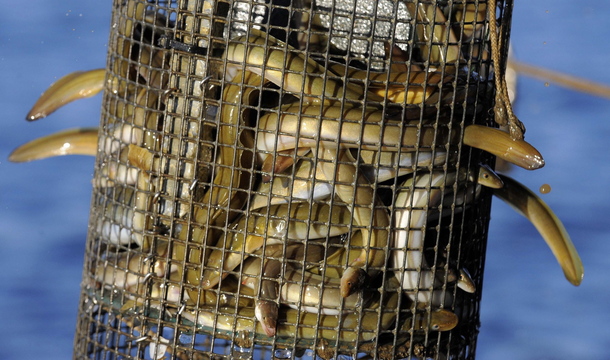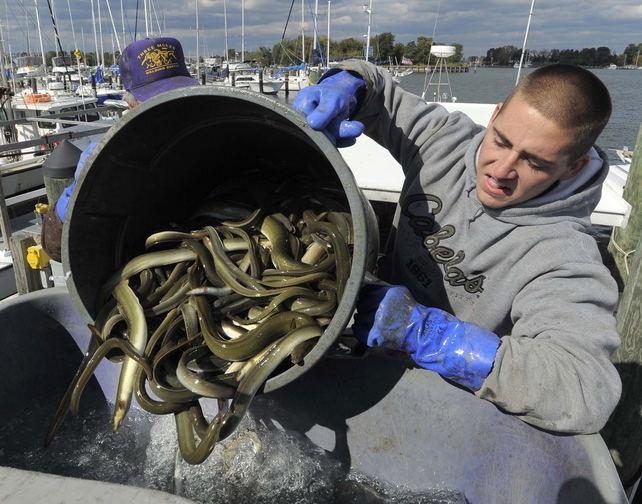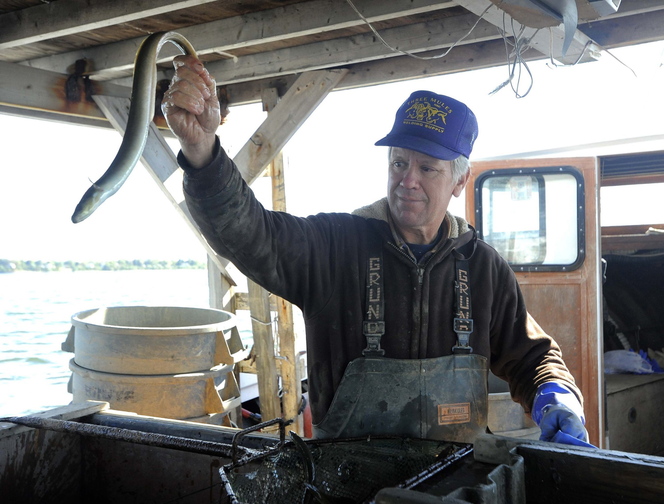SOLOMONS, Md. — On a chilly morning when other watermen on the Patuxent River dredged for oysters, Jimmy Trossbach sought more slippery quarry – American eels.
“I don’t know what we’ll find here,” Trossbach said as he guided his 45-foot workboat, Prospector, to a pair of empty plastic jugs bobbing on the water. His helper, Jake Walker, reeled in the eel pots they’d set two days before.
The first cylindrical mesh cage they hauled aboard pulsed with a writhing tangle of olive green. Walker dumped the eels into a wooden box with holes in its sides, and the snakelike fish slithered into a large tank of water.
“People will say, ‘I didn’t know there were so many eels out there,’” said Trossbach, 54, who’s been eeling for 26 years.
While there seem to be a lot in Maryland waters, scientists elsewhere have concluded that the Atlantic coast’s eel population has been depleted. Last week, the Atlantic States Marine Fisheries Commission put off a decision on catch limits until May while one state, Maine, works to slash its commercial harvest of young “glass” eels. The catch there surged in recent years to cash in on a booming export market, with nearly $39 million worth of the tiny translucent juveniles being shipped abroad, mostly to Asia.
Trossbach welcomed news that Maine would scale back its harvest, saying it threatened his livelihood. He is limited by Maryland regulations to harvesting more mature “yellow” eels, which must be at least 9 inches long.
But the prices that overseas buyers pay for larger eels have plummeted, Trossbach said, as the reported harvest of glass eels from Maine soared. The baby eels can be shipped abroad more cheaply and raised there, he said, undercutting demand for his larger specimens.
“It could easily put us out of business,” he said.
The U.S. Fish and Wildlife Service is weighing a conservation group’s petition to declare the American eel an endangered species, with an answer promised in 2015. Meanwhile, fisheries managers have been mulling action to curb the eel catch, which rebounded recently after a long decline.
There’s a lot the experts acknowledge they don’t know about the American eel, but they believe its numbers are at or near historically low levels. The decline stems from a combination of factors, they say, including overfishing, damming of rivers and changing climate and ocean conditions.
Although eels have largely disappeared from American tables, they remain popular delicacies in Europe and Asia. Many of Trossbach’s eels get sold as bait for crabbers and anglers, but about 40 percent of his catch goes overseas for human consumption.
He is in rare company in Maryland – a full-time eeler. He follows them up the bay in the spring, setting his 800 pots around Baltimore in the summer, and then back south as the water cools in the fall. He fishes until Thanksgiving.
For all his years pursuing the slippery creatures, Trossbach said there’s a lot about them that’s still a mystery to him.
“They are strange creatures, no doubt,” he said.
Eels are different from other fish, in more than just appearance. They spend most of their lives in fresh water and spawn in the Sargasso Sea near the West Indies. Their offspring return to the coast after months adrift on ocean currents, where they change appearance as they grow, from glass eels to darker elvers to yellow eels.
They spread out through the Chesapeake and migrate inland into fresh water — at least until stopped by dams — feeding on insects, worms, small shellfish and fish. They linger for five to 20 years before transforming one more time into “silver” eels and swimming back to the Sargasso to spawn and die.
The larger yellow eels fetch $2.50 to $3 a pound, Trossbach said, while glass eels go for $2,000 a pound. Glass eels are so small, there can be 2,000 or more in a pound, and Maine reported harvesting 20,000 pounds of them last year.
Maryland, by comparison, reported landing 556,000 pounds of the more mature yellow eels last year, the second largest haul since the state began tracking the commercial harvest in 1983.
Maryland has the highest landings by weight of any state on the coast, but Keith Whiteford, a state Department of Natural Resources biologist, said fishing pressure in state waters did not appear to be excessive..
“I think we fish them hard because we have a lot of eels,” Whiteford said.
But Leah Zabel, with the Center for Environmental Science, Accuracy and Reliability, said the California-based group believes that American eels are in much worse shape now than when it petitioned three years ago to have them protected from commercial harvest under the federal Endangered Species Act.
“It appears that poaching is an enormous problem,” she said, with exports of eels from Canada and Maine alone said to be two to three times what the officially reported harvest was.
The center sued the U.S. Fish and Wildlife Service last year after the agency acknowledged there were grounds to consider the petition.
The agency is working to restock the eel population in the Susquehanna River. Federal biologists reported they collected more than 270,000 young elvers below Conowingo Dam this spring and summer and released them upriver. In the past few years, they’ve trucked more than 400,000 above the dam.
Send questions/comments to the editors.





Success. Please wait for the page to reload. If the page does not reload within 5 seconds, please refresh the page.
Enter your email and password to access comments.
Hi, to comment on stories you must . This profile is in addition to your subscription and website login.
Already have a commenting profile? .
Invalid username/password.
Please check your email to confirm and complete your registration.
Only subscribers are eligible to post comments. Please subscribe or login first for digital access. Here’s why.
Use the form below to reset your password. When you've submitted your account email, we will send an email with a reset code.